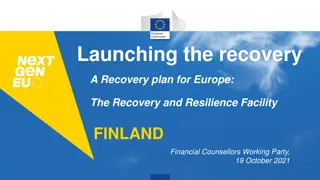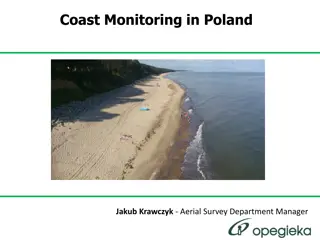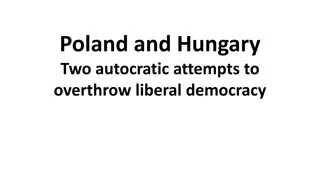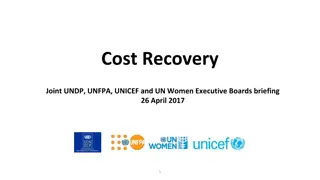Poland's Recovery and Resilience Plan Overview
Poland's Recovery and Resilience Plan aims to drive green and digital transitions, enhance resilience in various sectors, and support companies and SMEs for economic recovery. The plan includes key reforms and investments in energy, transport, buildings, climate adaptation, digitalization, public administration, healthcare, education, and more. It focuses on sustainable development, creating jobs, and boosting innovation to pave the way for a resilient future.
Download Presentation

Please find below an Image/Link to download the presentation.
The content on the website is provided AS IS for your information and personal use only. It may not be sold, licensed, or shared on other websites without obtaining consent from the author.If you encounter any issues during the download, it is possible that the publisher has removed the file from their server.
You are allowed to download the files provided on this website for personal or commercial use, subject to the condition that they are used lawfully. All files are the property of their respective owners.
The content on the website is provided AS IS for your information and personal use only. It may not be sold, licensed, or shared on other websites without obtaining consent from the author.
E N D
Presentation Transcript
A Recovery plan for Europe: The Recovery and Resilience Facility POLAND
Overview of todays documents Staff Working Document Annex to the Proposal for a Council Implementing Decision Proposal for a Council Implementing Decision Outline of the reforms and investments and their timeline for implementation (including milestones and targets) Outline and detailed explanations of the findings of the CID Legal agreement between the EU and Poland To be adopted by the Council Annex listing the climate and digital contributions per investment/measure Detailed provisions for disbursements upon fulfillment of milestones and targets
Overview of Polands RRP 49 reforms and 53 investments 6 components 35.4 billion 23.9 bn in grants 11.5 bn in loans 283 Milestones & Targets
Green transition Key reforms Energy: boost on/offshore wind Transport: low-emission vehicles, railways Buildings: reduce heating emissions Climate adaptation: sustainable water and better wastewater management 43% Almost 43% of plan allocation supports climate objectives Key investments Renewable energy sources - 5 bn Sustainable mobility - 7.5bn Improving air quality - 3.5 bn DNSH: No measure in the plan harms environmental objectives Appropriate flanking measures are applied where needed
Digital transition Key reforms Roll-out of high-speed broadband networks Reform in digitalisation of education Public administration 21% More than 21%of planallocation supports digital objectives Sector-specific actions Public administration Healthcare Transport Agri-food Innovation Education Key investments Connectivity - 2.6 bn Digital skills - 734 mn E-services - 420 mn Cybersecurity - 443 mn Cross-border projects Next Generation Cloud and Edge Infrastructure and Services
Resilience Companies and SMEs A more resilient public sector Digitalisation Reform of hospitals and investments in new medical equipment Better public employment services Social resilience Support for up/reskilling Support research & innovation Support to HoReCa, tourism and creative sectors S T Equal access to education Expansion of childcare and long-term care facilities Modernisation of vocational education and training Improving business environment Better law-making process Strengthened judicial independence Expansion of investment zones Reform of spatial planning laws
Strengthening judiciary independence The PL plan, as submitted in May 2020, did not include any measure related to the rule of law. To address the Council recommendation on the investment climate and to protect the EU's financial interests, the plan now contains 3 milestones to strengthen important aspects of the independence of the judiciary: Milestone 1 - Q2 2022 Milestone 2 - Q2 2022 Milestone 3 - Q4 2023 reform of the disciplinary regime for judges, with a new body and new grounds for disciplinary liability ex-post check to ensure completion of the review proceedings review proceedings for judges affected by rulings of the problematic Disciplinary Chamber of the Supreme Court Milestones 1 and 2 need to be fulfilled before the 1st payment request and before any funds are disbursed to Poland from the RRF.
Proposed governance framework for RRP implementation Monitoring and implementation arrangements are one assessment criterion Arrangements of the Polish plan are considered as adequate Implementation structure set-up consists of the following entities: Ministry of Funds and Regional Policy coordination Relevant ministries, public entities and local governments - implementation Audit body (a dedicated department at the Ministry of Finance) and 16 tax administration chambers (regional offices) - audit IT system used for data collection functionally linked with the Arachne risk-scoring tool (required by a separate milestone, for which implementation is needed for the first payment, in order to protect the EU's financial interests) Involvement of the stakeholders, including social partners will be institutionalised through the Monitoring Committee
Polands NGEU - Economic impact Up to 1.8% increase in GDP by 2026* 105 000 new jobs created* 15% increase in GDP in 20 years' time** *According to model simulations conducted by the European Commission using the QUEST model, taking into investments and spillovers from other Member States. account the Plan's **According to a Commission model-based exercise, including structural reforms. benchmarking
Next steps Commission raises necessary funds on markets by issuing bonds COUNCIL POLAND COMMISSION POLAND COMMISSION The Council approves Poland s national plan The Commission assesses Poland s RRP and transposes its content into a proposal for a Council Implementing Decision Poland requests disburse ments upon reaching agreed milestones and targets. Commission prepares preliminary assessment of the request Poland receives instalment of EU financial support Within two months Following the official submission by Poland Within one month Up to twice a year Following a Commission decision that takes into account EFC opinion Close cooperation with the European Parliament























